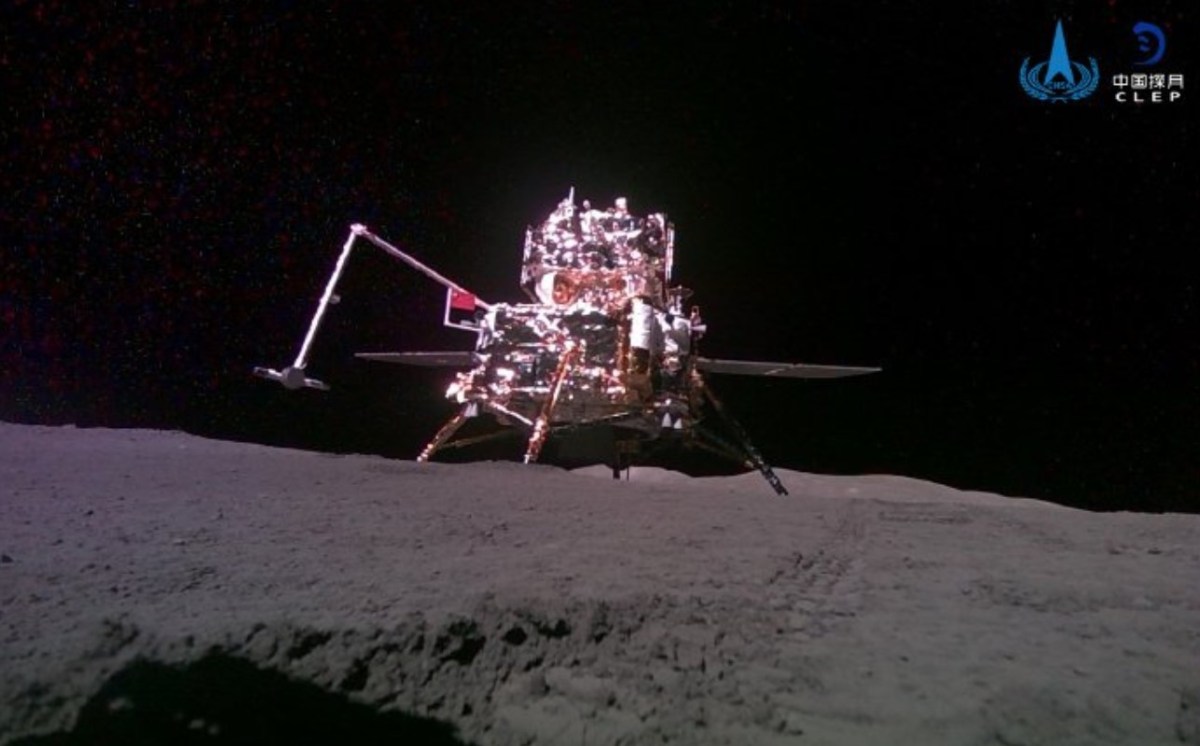HELSINKI — Material from the far side of the moon has begun its journey for Earth after Chinese spacecraft collected samples and launched them into lunar orbit.
The Chang’e-6 mission ascent vehicle lifted off from atop the mission lander in Apollo crater at 7:38 p.m. Eastern June 3 (2338 UTC), the China National Space Administration (CNSA) announced. The ascender is now tracking the Chang’e-6 orbiter in a retrograde low lunar orbit.
Chang’e-6 landed on the lunar far side late June 1 and began collecting rock and regolith samples with a scoop and drill shortly afterwards. Up to 2,000 grams was then loaded into the ascent vehicle.
“The packaging work has been completed in a normal condition and the whole process is smooth,” Li Xiaoyu, an engineer from the Beijing Aerospace Control Center (BACC), told CCTV.
The ascent vehicle lifted off and achieved autonomous positioning and attitude determination with the assistance of the Queqiao-2 relay satellite.
Big bunch of Chang’e-6 updates: At 2338 UTC June 3 the ascender launched from atop the Chang’e-6 lander, carrying the samples into orbit. Here’s the action seen from the lander: pic.twitter.com/IcNUAqcFxS— Andrew Jones (@AJ_FI) June 4, 2024
The successful sample and ascent operations are crucial steps in the complex, four-spacecraft mission to deliver unique and scientifically valuable lunar far side samples to Earth.
The ascent vehicle is expected to rendezvous and dock with the mission’s service module in the next couple of days. Both spacecraft will be traveling at around 1.6 kilometers per second during the maneuvers.
After docking, sample canisters will then be transferred to a reentry module via an automated process. The ascent vehicle will then be discarded while the service module awaits a calculated time to begin its return to Earth. This is expected around June 20-21, with the reentry module to land in Inner Mongolia around June 25 Beijing time.
China has not published planned timings for milestones, but the mission is proceeding in a similar manner as the 2020 Chang’e-5 nearside sample return mission. Chinese space officials have previously indicated the mission would last 53 days.
Boost for lunar and deep space plans
The launch from the lunar surface and the expected rendezvous and docking in lunar orbit will be applicable experience for China’s plan to put astronauts on the moon and return them safely to Earth before 2030. The sampling will also be useful for deep space endeavors such as the upcoming Tianwen-2 asteroid and comet mission. China also plans to launch the Tianwen-3 Mars sample return mission around 2030.
“The mission is quite tough,” Ge Ping, Chang’e-6 spokesperson and deputy director of the Lunar Exploration and Space Engineering Center under CNSA, told CCTV regarding Chang’e-6. “We launched the Queqiao-2 relay satellite in the early stages, adopted technologies on rapid intelligent sampling and take-off and ascent from the moon’s surface, which have laid a solid foundation for technologies, such as soft landing and sampling on extraterrestrial bodies.”
Queqiao-2 launched in March and entered a specialized lunar orbit. From there it facilitates communications with the lunar far side, which is always facing away from Earth.
Chang’e-6—a roughly 8.2-ton stack of four spacecraft—launched May 3 from Wenchang spaceport. It entered lunar orbit around 4.5 days later. The roughly 3.2-ton mission lander successfully touched down on the moon at 6:23 p.m. Eastern June 1. The lander targeted a southern portion of Apollo, a mid-latitude crater within the vast and scientifically intriguing South Pole-Aitken (SPA) basin.
The Chang’e-6 lander also released a small rover which imaged the main spacecraft. Drive tracks can be seen in the lunar regolith. The image shows the lander and its solar arrays, a deployed scoop arm. A Chinese national flag is also visible, deployed after sample collection was completed. The ascent vehicle is atop the lander. A panoramic camera also captured the lander’s surroundings.
International payloads, future missions
The French space agency also announced its DORN payload to detect radon outgassing was successfully turned on and collected data. The payload was turned off ahead of launch of the ascent vehicle. The lander also carries the Negative Ions at the Lunar Surface (NILS) payload developed by the Swedish Institute of Space physics, which CNSA confirmed turned on. An Italian passive laser retro-reflector is also aboard the lander.
Samples could contain material ejected from deep below the moon’s crust. This and other material may provide insight into why the near and far sides are so different, as well as clues as to the history of the early solar system.
Chang’e-6 is part of China’s broader lunar program. The country will follow up with two missions to the south pole of the moon. These are Chang’e-7 in 2026 and Chang’e-8 around 2028. The country aims to launch its first crewed lunar mission by 2030.
Both sets of missions are part of a plan to establish a permanent lunar base. This project is known as the International Lunar Research Station (ILRS) program, planned for the 2030s. A number of countries and organizations have signed up to the project.
